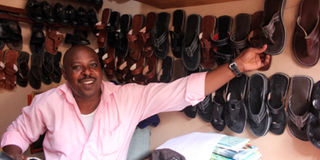Livestock ban hurts leather processors

A man shows some shoes he has made from hides and skin.
What you need to know:
Ban lifted. Although the ban was lifted in early December, leather processors are yet to recover from the pinch.
Kampala.
Business for local leather processors has been slow following a disease outbreak that spurred a livestock ban in major livestock producing areas. Last year Information from the Ministry of Agriculture indicates that the foot and mouth disease outbreak started in February in the western region, rapidly spreading to nearly 28 districts in the cattle corridor, prompting a nation-wide quarantine and an eventual restriction of livestock trade in the affected areas.
According to Emmanuel Mwebe, the coordinator of the Uganda leather and Allied Industries Association, sector players started feeling the pinch in the middle of last year, resulting from scarcity of the hides and skins on the local market.
This pushed manufacturers to import the raw material from neighbouring countries, which raised production costs.
Mr Mwebe says, “The quarantine just made the situation worse since a large proportion of Ugandans prefer imported leather products to domestic products, which are perceived to be of low quality.”
Ms Victoria Byoma, chairperson of footwear and Leather Goods manufacturers and exporters association said, “Ugandan hides and skins are naturally of high quality, high texture and heavy substance which are suitable for the production of excellent heavy upper and vegetable tanned sole leather. Any slight hiccup in the flow of raw material hugely affects business.”
She explained that on average, a Ugandan hide weighs 16 kilogrammes and has 29 feet of which about 20 per cent can be used as fabric, making Uganda the only country in East Africa with larger quantities of hides that are suitable for such purposes.
Figures from the Uganda Bureau of Statistics 2013 show Uganda has potential to produce 1.4 million cattle hides, 3.1 million goatskins and nearly 700,000 sheep skins annually. But the Uganda Leather and Allied Industries Association indicate current collection rates are at 1.2 million of cattle hides, 2.4 million goatskins and 540,000 sheep skins respectively.
International demand
High demand for Ugandan hides on the international market has wooed more investors to the Ugandan market. Uganda now has nine medium-sized tanneries which process upto wet-blue level.
“The ban was lifted on December 3; meaning slaughtering is authorised. Vaccination is still on-going in some areas. Next year, importation of hides will be no more. Businessmen will have their factories running normally and costs going down,”` said Dr Nicholas Kauta, the director of animal resources at the ministry of agriculture.
Despite limited raw materials, Mr Mwebe says with the recent introduction of a levy on raw hides and skins export, there are foreign interests in leather tanning ventures.
This, she says, which will further spur interest down the industry chain, especially in leather manufacturing.
Tannery has increased from seven to nine tanneries including a leather processing training school.
Out of the five major tanning industries, only Jinja-based Leather Industries of Uganda processes hides and skins up to the finished product stage. The other four tanneries; Skyfat Tanneries, Novelty Investment, Jambo Tannery and Gomba Fish Skins Industry, only process hides and skins to wet blue for export.




